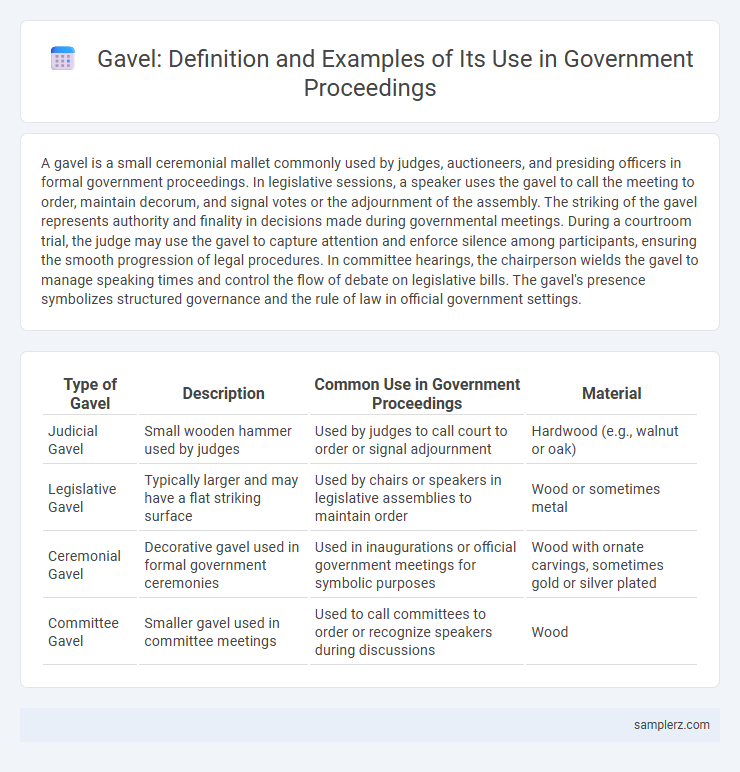A gavel is a small ceremonial mallet commonly used by judges, auctioneers, and presiding officers in formal government proceedings. In legislative sessions, a speaker uses the gavel to call the meeting to order, maintain decorum, and signal votes or the adjournment of the assembly. The striking of the gavel represents authority and finality in decisions made during governmental meetings. During a courtroom trial, the judge may use the gavel to capture attention and enforce silence among participants, ensuring the smooth progression of legal procedures. In committee hearings, the chairperson wields the gavel to manage speaking times and control the flow of debate on legislative bills. The gavel's presence symbolizes structured governance and the rule of law in official government settings.
Table of Comparison
| Type of Gavel | Description | Common Use in Government Proceedings | Material |
|---|---|---|---|
| Judicial Gavel | Small wooden hammer used by judges | Used by judges to call court to order or signal adjournment | Hardwood (e.g., walnut or oak) |
| Legislative Gavel | Typically larger and may have a flat striking surface | Used by chairs or speakers in legislative assemblies to maintain order | Wood or sometimes metal |
| Ceremonial Gavel | Decorative gavel used in formal government ceremonies | Used in inaugurations or official government meetings for symbolic purposes | Wood with ornate carvings, sometimes gold or silver plated |
| Committee Gavel | Smaller gavel used in committee meetings | Used to call committees to order or recognize speakers during discussions | Wood |
The Role of the Gavel in Parliamentary Procedures
The gavel serves as a crucial symbol of authority and order in parliamentary procedures, used by the presiding officer to signal the commencement and adjournment of meetings. Striking the gavel commands attention, maintains decorum, and enforces rules during debates and voting sessions. Its role ensures structured dialogue and efficient decision-making within legislative and governmental assemblies.
Historical Significance of the Gavel in Government Meetings
The gavel, symbolizing authority and order, has been a key instrument in legislative and judicial proceedings since the early 19th century. Its historical significance lies in its role to maintain decorum and signal the commencement or adjournment of government meetings, reflecting centuries-old parliamentary traditions. Prominently used in the United States Congress and countless municipal councils worldwide, the gavel embodies the procedural discipline essential to democratic governance.
Gavel Use in Legislative Sessions: A Step-by-Step Example
During legislative sessions, the gavel is used by the presiding officer to call the assembly to order, signal the start and end of debates, and maintain decorum. For example, the speaker strikes the gavel once to open the session, twice to restore order during disruptions, and thrice to adjourn proceedings. This structured use of the gavel ensures orderly conduct and efficient progression of legislative business.
Opening a Government Hearing: The Gavel’s Function
The gavel signals the official start of a government hearing, commanding attention and establishing order in the room. Its decisive strike marks the transition from informal discussions to formal proceedings, underscoring the authority of the chairperson or presiding officer. This symbolic tool enforces procedural discipline and ensures that all participants recognize the hearing's commencement.
Maintaining Order: Gavel Actions During Heated Debates
The gavel symbolizes authority and is repeatedly struck to restore calm during heated government debates, signaling members to maintain decorum. During these moments, the presiding officer uses the gavel to pause discussions and enforce procedural rules, ensuring orderly conduct and preventing disruptions. This traditional practice reinforces the solemnity of legislative proceedings and upholds the integrity of democratic processes.
Closing Proceedings: The Gavel Signal Explained
The gavel striking the sound block signals the official close of government proceedings, marking the end of deliberations or a session. This action serves as a formal cue for participants to disperse, ensuring order and finality in legislative or judicial meetings. The gavel's decisive tap underscores the authority of the presiding officer in managing the procedural flow and maintaining decorum.
Symbolism of the Gavel in Judicial versus Legislative Contexts
The gavel symbolizes authority and order in both judicial and legislative settings but carries distinct connotations in each. In judicial proceedings, the gavel represents the judge's power to control the courtroom, maintain decorum, and render decisions authoritatively. In legislative contexts, it signifies the presiding officer's role in managing debates, enforcing rules, and facilitating orderly voting processes within assemblies or parliaments.
Notable Examples of Gavel Use in Major Government Events
The gavel played a pivotal role during the United States Senate impeachment trial of President Andrew Johnson in 1868, symbolizing the authority of the presiding officer. In the historic 1963 March on Washington, the gavel was used to maintain order during key speeches and legislative discussions. The annual State of the Union addresses also prominently feature the gavel as a tool to call sessions to order and uphold parliamentary procedure.
Protocols for Passing the Gavel in Official Proceedings
In government proceedings, the protocol for passing the gavel involves a formal transfer of authority from the current presiding officer to the successor, often marked by a symbolic gesture and an official announcement. This practice ensures a clear and orderly transition of leadership during legislative sessions or committee meetings. The gavel signifies the power to maintain order and conduct the proceedings according to established rules and decorum.
Gavel Etiquette: Rules and Customs in Government Assemblies
Gavel etiquette in government assemblies requires the presiding officer to use distinct, firm strikes to call the meeting to order, maintain decorum, and signal the adjournment. Proper gavel use demonstrates authority and respect, ensuring orderly conduct during legislative or council sessions. Misuse or excessive striking of the gavel can undermine the formal proceedings and distract members from the agenda.

example of gavel in proceeding Infographic
 samplerz.com
samplerz.com